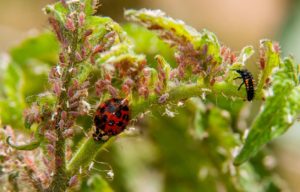Biological Control With Predators and Parasitoids
go.ncsu.edu/readext?667605
en Español / em Português
El inglés es el idioma de control de esta página. En la medida en que haya algún conflicto entre la traducción al inglés y la traducción, el inglés prevalece.
Al hacer clic en el enlace de traducción se activa un servicio de traducción gratuito para convertir la página al español. Al igual que con cualquier traducción por Internet, la conversión no es sensible al contexto y puede que no traduzca el texto en su significado original. NC State Extension no garantiza la exactitud del texto traducido. Por favor, tenga en cuenta que algunas aplicaciones y/o servicios pueden no funcionar como se espera cuando se traducen.
Português
Inglês é o idioma de controle desta página. Na medida que haja algum conflito entre o texto original em Inglês e a tradução, o Inglês prevalece.
Ao clicar no link de tradução, um serviço gratuito de tradução será ativado para converter a página para o Português. Como em qualquer tradução pela internet, a conversão não é sensivel ao contexto e pode não ocorrer a tradução para o significado orginal. O serviço de Extensão da Carolina do Norte (NC State Extension) não garante a exatidão do texto traduzido. Por favor, observe que algumas funções ou serviços podem não funcionar como esperado após a tradução.
English
English is the controlling language of this page. To the extent there is any conflict between the English text and the translation, English controls.
Clicking on the translation link activates a free translation service to convert the page to Spanish. As with any Internet translation, the conversion is not context-sensitive and may not translate the text to its original meaning. NC State Extension does not guarantee the accuracy of the translated text. Please note that some applications and/or services may not function as expected when translated.
Collapse ▲ What is Biological Control?
What is Biological Control?
Biological control (or “biocontrol”) is a pest management strategy that can benefit both conventional and organic agriculture. By enhancing the role of natural enemies, the negative impact of a pest on a crop is reduced.
Biological control can refer to the augmentation of native natural enemy populations as well as the introduction of non-native natural enemies. Although a few early efforts at non-native biological control created unexpected problems (such as the introduction of the cane toad to Australia), modern biological control entails a much more sophisticated understanding of ecological communities. Today, biological control is subject to strict regulations and testing to ensure that introductions can be done without disrupting native ecosystems.
Benefits
One benefit of biocontrol is reduction in pesticide use, which can reduce input costs, enhance ecosystem services (e.g. pollination), and protect environmental and human health. For labor-intensive crops such as many tree fruits and vegetables, reductions in pesticide use also allow more time in the field to harvest or manage plants (due to pesticide re-entry (aka restricted-entry) intervals (REI) and preharvest intervals (PHI)). Furthermore, by reducing the use of pesticides, the selection pressure on crop pests is reduced and the development of insecticide resistance is delayed.
High-value vegetables grown in North Carolina have a low tolerance for damage. This has resulted in a high dependence on chemical control, especially for direct pests that feed on fruit itself (e.g. stink bugs and caterpillars). For indirect pests that feed predominantly on foliage (e.g. spider mites, aphids, thrips), there is a higher tolerance for damage and more time for biological control to occur. For this reason, biocontrol can be highly effective for indirect pests but is more challenging against direct pests.
Biological Control for Specific Pests
- Spider mite management with Phytoseiulus persimilis
- Brown marmorated stink bug (BMSB) management with predators and parasitoids


